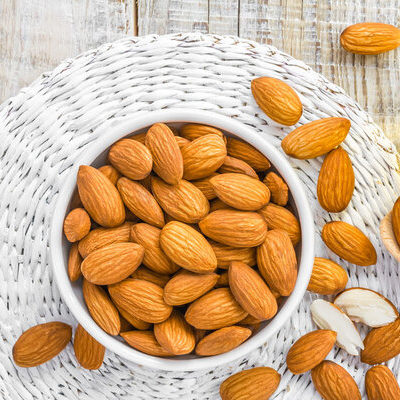
Almond
What are Almonds?
Almonds are the brown seeds of the fruit of the almond tree, which are considered drupes or stone fruits. These tree nuts are sold shelled and unshelled in stores across the globe. Blanched almond, almond flour, almond milk, almond butter, and almond meal are also sold after the processing of this raw tree nut.
- The outer shell is often repurposed as livestock feed and bedding.
- These tree nuts come in hundreds of different varieties and are classified in different ways in different countries, based on the hardness of the shell or the place of origin.
The most popular almonds around the world are:
- Duoro Almond (Portugal)
- Mandorla di Toritto (Italy)
- Mandorla di Avola (Italy)
- Mandorle (Sicily, Italy)
- Cypriot Sugared Almonds (Cyprus)
- Almond of Mallorca (Spain)
- Marcona (Spain)
Origin of the almond nut
Almonds are believed to be one of the first trees to be domesticated. However, wild almonds contained high levels of cyanide, which made them dangerous for humans. Later on, a natural mutation occurred, making them safe to eat. These tree nuts are native to Iran, although they spread to Mediterranean countries through trade by 100 BC. Pliny the Elder, a Roman writer, wrote that the Romans discovered how to remove the poison from this nut by piercing the trunk of the tree with pinewood. These nuts were even considered a charm for fertility in Ancient Rome.
Traders traveling along the Silk Road from Asia to Europe fed on these tree nuts, as they were plentiful in Central Asia. Franciscan monks later brought the almond tree to the Americas, where it flourished. Today, this tree nut is grown worldwide and is consumed across geographical regions and cultures.
Nutrition
The nutritional value for 100 g serving is:

Almonds are high in fat, protein, fiber, calcium, iron, and potassium. They are also rich in niacin, pantothenic acid, riboflavin, thiamin, vitamins B6 and E, as well as copper, magnesium, manganese, phosphorus, and zinc. These tree nuts have a low glycemic index, making them perfect for diabetics. These tree nuts are also associated with cardiovascular health, because of their tendency to reduce LDL cholesterol. Furthermore, these nuts have antioxidant and anti-inflammatory properties due to the polyphenolic compounds in them, namely flavonoids and proanthocyanidins, which are mainly located in the skin.
However, the processing of almonds may lead to some loss of nutrients. Roasting leads to distortion of the protein and damage of cell walls. Blanching may lead to alteration in cytoplasm and loss of nutrients. Nutrients may also be lost with particle size reduction.
Commercial production
These tree nuts require fertile, loamy soils that allow water retention and root aeration. First, almond trees are transplanted and take around 3 to 4 years to produce fruit. Each tree has a lifespan of 20 to 25 years. Then, these nuts are harvested and hulled to remove any impurities before they are shelled and packed. Stored nuts are often fumigated for insect control.
Since these tree nuts are a very profitable cash crop, more and more farmers are growing them. However, this has led to droughts in California over the past few years due to mono-cultured farming that does not allow for crop rotation and uses high amounts of water. Almond farming takes up 10 percent of California’s water usage.
The United States is the top almond production country in the world, followed by Spain, Iran, Morocco, Syria, Italy, Australia, Algeria, and Turkey. The USA is also the top consumer of this nut, followed by India, Germany, and Spain.
Almond recipes
Almonds are extremely versatile and can be used in both sweet and savory dishes. Some common uses include sweets, desserts, soups, main dishes, salads, oil, liqueur, butter, milk, and flour. Here are a few popular recipes:
- Almond Butter
- Almond Cake
- Badam Barfi
- Almond Cookies
- Badam Halwa
- Almonds and Pistachios Brittle
- Cauliflower and Almonds Soup
- Ghorabieh
- Ghotab Pastry
- Shakarli Bodom
- Ergolavi
- Almond Flour Fufu
- Banketstaaf
FDA regulations
The FDA regulates almonds as tree nuts and has specific regulations regarding their packaging. These nuts can also be sold in mixed nuts products, which require at least four or more different types of nuts in a single package. The USDA sets the standards and grades for this nut, which specify the maximum defects and foreign particles allowed.
References
Szalay, Jessie. “Almonds: Nutrition & Health Benefits.” Livescience.com, Live Science, 20 Oct. 2017, www.livescience.com/51627-almonds-nutrition.html.
“Almonds – Types and Varieties.” Frutas-Hortalizas.com, Interempresas Media, S.L., www.frutas-hortalizas.com/Fruits/Types-varieties-Almond.html.
Artem Milinchuk, A Brief History of Almonds, Farm Together, https://blog.farmtogether.com/a-brief-history-of-almonds
Almonds, University of California Drought Management http://ucmanagedrought.ucdavis.edu/Agriculture/Crop_Irrigation_Strategies/Almonds/
Almonds, FDA, Western Institute for Food Safety & Security, https://www.wifss.ucdavis.edu/wp-content/uploads/2016/10/Almonds_PDF.pdf
Almonds, The Nutrition Source, Harvard T. H. Chan School of Public Health, https://www.hsph.harvard.edu/nutritionsource/food-features/almonds/
